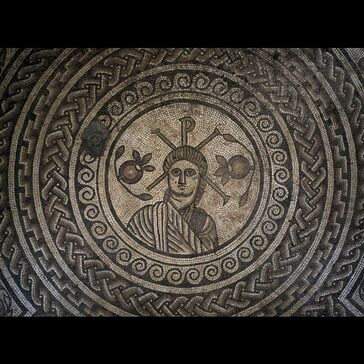
The Hinton St Mary Mosaic, discovered in Dorset, England.
Introduction
The Mosaic was discovered in 1963 in the floor of an ancient building in the village of Hinton St Mary, England.It is one of two floor panels which were used to cover the floor made of concrete. The center image of the Mosaic is what many scholars believe to be the erliest image of Christ discovered to date.The Mosaic dates back to the 4th century AD and was made during the Roman rule of Britian. Its dimensions are 8.1m in length and 5.2m in width. [The British Museum]
Invention
The mosaic was discovered in 1963 by Mr. W.J. White within two hundred yards of his home in Hinton St. Mary, England. The mosaic of Hinton St. Mary is largely important for the images which it contains. It is also important becasue through discovery and excavation of this mosaic we learn many things about how it was built. The Mosaic was most likely made in a separate location other than where it would come to rest as the floor of a villa. The Pavement was made of many individual tiles which were after being assembled in another place then moved to this villa to be reassembled on the floor. The mosaic is held together by mortar. Scholars have found through excavation of the area directly under the pavement that two seperate forms of mortar were used. This suggest that the tiles were assembled in one location being held together by mortar, and then moved to their final location. Once moved they were secured to the floor by a separate type of mortar. [Painter 1967]
Roman Britain
As with most of the areas that theRomans conquered thier influence was absorbed into the culture quite profoundly. The cultural influence of the Romans was very evident among wealthy merchants. Before the Romans invaded Britain there was a Celtic culture occupying the territory. As the Roman culture began to blend ito the Celtic culture the upper class began to become educated in the ways of the Romans and many learned the Greek language. One of the was the Celts were influenced by the Roman system of polytheism was the worship of Greek gods. The images of these gods were often made into busts and shown on paintings and murals. While many people were worshiping these gods a new form of religion began to slowly incorporate its self into the culture, Christianity. As Christianity became more readily accepted among the Celtic culture it became evident in the art of the period. Christian symbols were often blended into art. The Hinton St. Mary Mosaic is one such example of how the art and culture of this Roman Britian was influenced by Christianity. [Encyclopedia Britannica]
Historical World Significance
As one of the earliest known pictorial depictions of Christ, this Mosaic bears a very important historical significance. The image of a human torso on the mosaic is not at all uncommon for the time. While the depictions of a human torso is relitivly unimportant the mosaic also depicts four other figures all of which are lodged in greek mythology. The depiction of Christ as the center image is recognized by the Greek letters Chi and Rho, which are the first two letters of the Greek word for Christ. The letters are positioned behind the center of the figure helping to reassure whoever was viewing the image that this was Chirst. Up untill this time most Christian cultures had yet to develop an image of Christ. One such reason that the Romans would be alright with viewing the image of Christ is because they were accustomed to seeing their gods portrayed all around them. [Jim Grant 2008]
Suggested Bibliography
Jim Grant, Sam Gorin, Neil Fleming. In The Archaeology Coursebook: an introduction to themes, sites, methods and skills, by Sam Gorin, Neil Fleming, Jim Grant, 186-187. Taylor & Francis US, 2008
Painter, D.S. " The Roman Site at Hinton St Mary, Dorset." The British Museum Quaterly, 1967: 15-31. The British Museum. "
The Hinton St. Mary Mosaic." The British Museum. http;//www.britishmuseum.org/explore/highlights/highlight_objects/pe_prb/t/the_hinton_st_mary_mosaic.aspx (accessed April 19, 2011)
Encyclopedia Britannica. " Roman Britain." Accessed April 20, 2011. http;//www.britannica.com/EBchecked/topic/615557/United-Kingdom/44735/Roman-Britain
http://www.bbc.co.uk/ahistoryoftheworld/objects/VfupdXVjTM6crACGDU-6uA